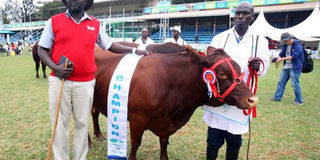Unlock success to dairy farming with these guidelines

Dr Erick Otieno with his winning cow and the caretaker Julius Ronoh at Jamhuri Park Show Grounds, during the Livestock Breeders show and Sale 2016. PHOTO | EVANS HABIL | NATION MEDIA GROUP
What you need to know:
- Taking pre-cautions will help you achieve a sound health, good animal welfare, social responsiveness, high milk production and improved cost control.
- Record keeping is essential as through it, you will be able to tell if you are making profits and know your weak areas and adjust.
- Develop a system to allow for easy removal of manure from the barns. Other useful options include construction of a biogas.
Investing in dairy farming needs to be done in a cautious manner in order to optimise efficiency of available farm resources, or, simply put, to help you do more with less.
Taking pre-cautions will help you achieve a sound health, good animal welfare, social responsiveness, high milk production and improved cost control – all that defines a profitable dairy farm.
Unlock your dairy farming implies that you start smart as soon as you begin. This is however built on four simple but very important interlinking pillars:
1. Dairy investment plan
This is the initial step and the most vital player in getting dairy farming right. Producing and sustaining high quality milk in today’s competitive dairy is complex, allowing no room for mistakes, thus more time should be spent for informed decision making when setting up plans.
Just to summarise, a dairy investment plan outlines the finances required -- cow house design, land required and feeding plans, etc. It also takes care of all the logistics for future expansion.
For example, if you want to begin with three heifers, dairy investment plans will show you how much you will incur to buy the cows with regard to price variations, the conventional running costs you will incur till you start milking and the cost of inputs you are using to produce a litre of milk.
This means, you will be able to tell if you are making profits plus the margins. This will clearly pin point your weak areas requiring adjustments, since it is not strange to find a dairy farm with large herd of cattle making less profit than one with few herd of cattle with higher production.
A good investment plan also frameworks future expansion aspects; you are able to tell how long it will take you to grow your herd to some specific number you target with all the cost implications assuming now new cows are bought.
2. Feed
Helps you plant, conserve and preserve enough fodder for resilience and realise a noticeable lift in feeding to sustain your farm even over dry periods.
Feeding entails use of forages, fodder, concentrates or preserved feed sources. Decent planning may require you to make some silage in advance, stock enough bales of hay, plant grasses like Boma Rhodes, Kikuyu grass and other protein rich sources before you bring in your animals.
The choice of feeding depends upon your decision and availability of feeding materials. This implies that you may decide to go Total Mixed Rations or use conventional fodder plus supplements; either way you are on the right track.
A well planned feeding strategy will ensure you have plenty of quality feeds for your incoming animals and cushion you from feed related risks and threats that come by.
For example, you can tell how much silage you need to take you for certain period of time with your current dairy stock if you want to make silage.
Water is the cheapest feed, thus should not pose much threat to your dairy farming.
3. Cow house construction
Keeping your cows in top health conditions starts with cow comfort. Cows cannot explain all that make them comfortable and keep then in optimal production; it stems from having a good cow barn.
Installing sustainable cow barns require considerable investments and proper designing to take care of cow comfort, offer sound health and hygiene, production and future expansion.
Best designed cow barns are made from what is readily available to achieve environmental friendliness, simplicity and cost efficiency from construction materials available, whether timber or metals.
The Kenya Market-led Dairy Program has developed a modular cow barn design to give farmers room for future expansion as you grow your stock gradually provided site selection provide space to grow with minimal cost implications.
These designs also take care of easily accessible feed and water trough placements, fresh air flow, soft and clean sleeping cubicles and coarse ground for sound animal footing.
It also offers opportunities for use of renewable sources of energy such as solar lighting and biogas production to help you save on costs on conventional energy sources.
Other physical structures that accompany cow house include hay barn, silage shed and stores. Construction of error-free housing structures or units require that dairy experts to work with building contractors.
4. Buy a cow
The trend in poultry production is that one-day-old chicks arrive after brooders and feeds are secured, this applies to dairy farming. With your cow barn and feeding programme set, now you can embark on identification and buying of dairy cows.
Source animals from reputed farms using records to have a glimpse of origins and performance of the animals you intend to buy.
5. Other things to consider
- Works with professionals: Experts empower you with dairy standard operational procedures to support you up to the last production goals. Identify and build trust to get the best out of them.
- Herd fertility and calf rearing: Future of any dairy enterprise heavily relies on these; using the right breeding techniques and managing your calves well are steps forward in achieving these.
- Labour efficiency:Good rapport and mutual working relationship with the farm assistants.
- Waste management:Manure from dairy animals is not environmental friendly if left to accumulate or when not properly disposed. Develop a system to allow for easy removal of manure from the barns. Other useful options include construction of a biogas.
All these coupled with high level standards hygiene and best management practices will make dairy cows work for you, not vice versa!
***
Felix Akatch Opinya, Animal Breeding and Genetics, Egerton University





